Your Pregnancy at Week 36
sciencephoto
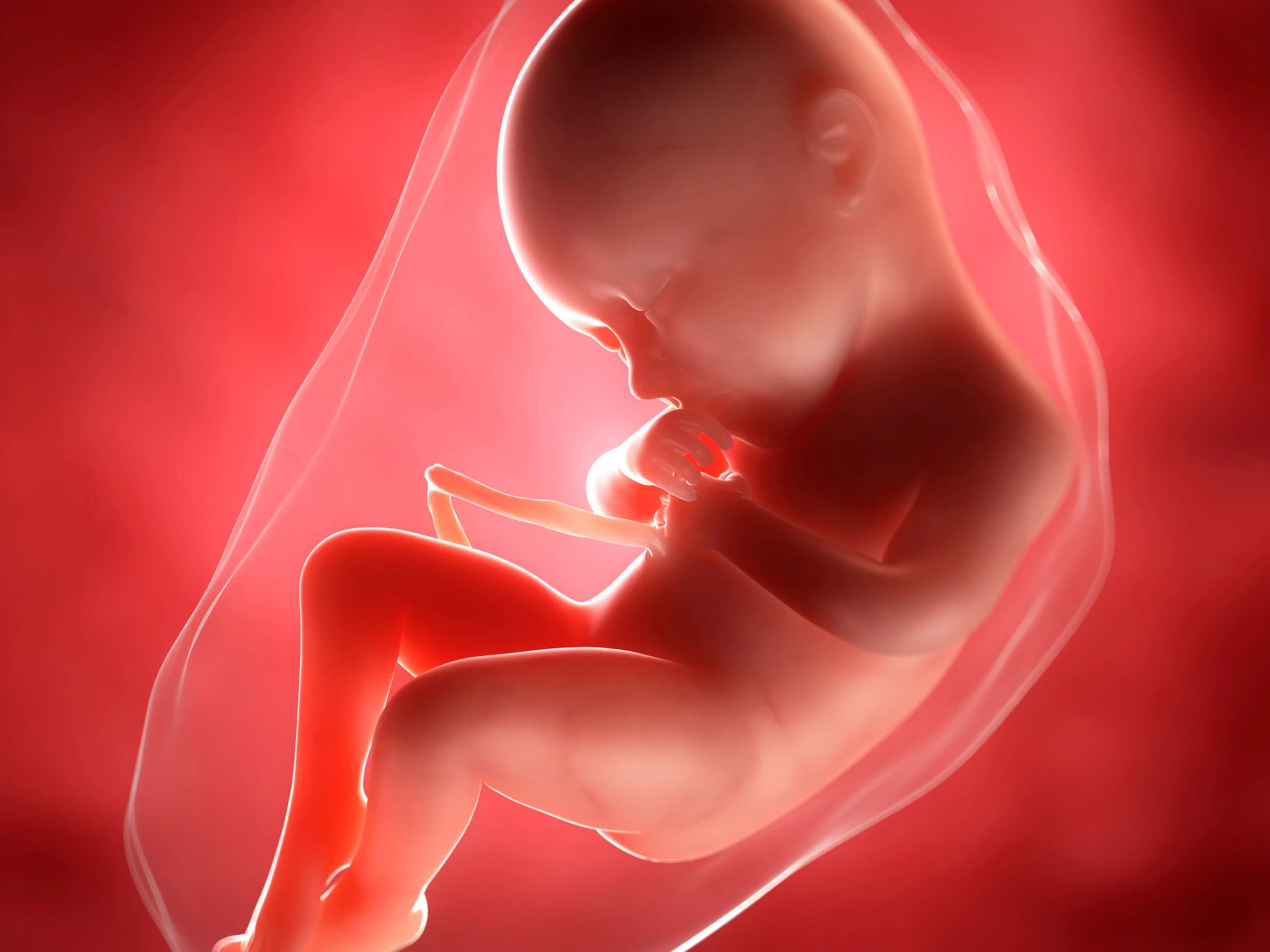
Written by Mindsmaking Medical Writer
Fact Checked by Mindsmaking Professionals
27th, July, 2025
Welcome to week 36 of pregnancy! Your baby is preparing for birth, gaining weight and maturing organs. Your body is also adjusting, and you might feel new sensations.
Welcome to the 9th month or the 36th week of carrying your little treasure. Your baby is just about ready to meet you for the first time. In about four weeks, you will see your baby face-to-face.
While everyone knows that it takes nine months to be pregnant, doctors record pregnancies in weeks. You now have four weeks remaining to complete your journey, and the exact due date is a secret that your baby does not feel like telling you yet. Meanwhile, the baby is about to complete its development.
Key Takeaways
Most babies begin to move into the head-down position around 36 weeks in preparation for birth. By 37 weeks, most babies will be in this position, though 3-4% may remain breech.
Your baby measures around 19 inches and weighs about 2622 grams, comparable to a romaine lettuce.
You may feel like there's little room left for the baby to grow and be tired of feeling so large, but the longer the baby remains in the womb until the due date, the better.
Your uterus will have completed its expansion by around 36 weeks or shortly after, potentially weighing around 2 ½ pounds.
As the baby moves down into the pelvic cavity, pressure on the diaphragm decreases, making it easier to breathe and eat as the stomach feels less compressed.
Contact your doctor immediately if you notice fewer than 10 movements in an hour or are concerned about your baby's activity.
Avoid electronic screens before bed to improve sleep quality, as blue light can disrupt melatonin production.
In addition to your partner's hospital bag, you should pack a few essential items for the delivery.
Reviewing the signs of labour with your doctor or midwife can help you get clear instructions on when to call and go to the hospital or birth centre.
Take a peek
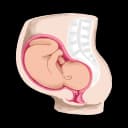
Lung Development
Your baby's lungs are fully developed and ready to function, allowing them to take their first breath after birth.

Cute baby
This week, your baby looks more like an infant, with chubby cheeks and a fuller face.
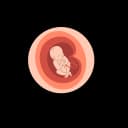
Baby position
Around this time, your baby may start moving into a head-down position in preparation for birth. By 37 weeks, most babies will have assumed this position.
Baby Development at Week 36
At 36 weeks, your baby is fully gearing up for birth. The lungs are now developed and ready for that crucial first breath after birth. Until then, your baby's lungs will stay deflated, with all oxygen needs still being met by the placenta.
The small, wrinkled foetus you saw in earlier ultrasounds is quickly developing into a chubby baby. The addition of fat, particularly in the cheeks, along with strong sucking muscles, gives your baby a fuller face. Your baby weighs 2622 grams.
The bones in your baby's skull are flexible and can shift and overlap to help them navigate the birth canal. This process, known as moulding, may result in a pointy or misshapen head at birth. However, this is normal and temporary; your baby's head will typically return to a more rounded shape within a few hours or days(4).
The fine, downy hair known as lanugo that has covered your baby's skin is starting to fade, along with the vernix caseosa. Vernix caseosa is the thick, creamy substance that protects your baby's skin while immersed in amniotic fluid. Your baby will ingest both lanugo and vernix, as well as some amniotic fluid, which will then combine to form meconium, the first stool your baby will pass after birth. Around this time, your baby may move into the head-down position in preparation for birth. By 37 weeks, most babies will have positioned themselves this way.
However, don't worry if your baby hasn't turned yet. Most babies will move into the head-down position in the final weeks of pregnancy, but 3-4% of babies will remain in a breech position(2).
Suppose your baby remains in a breech position by next week. In that case, your healthcare provider might suggest an external cephalic version to turn the baby into the head-down position(1).
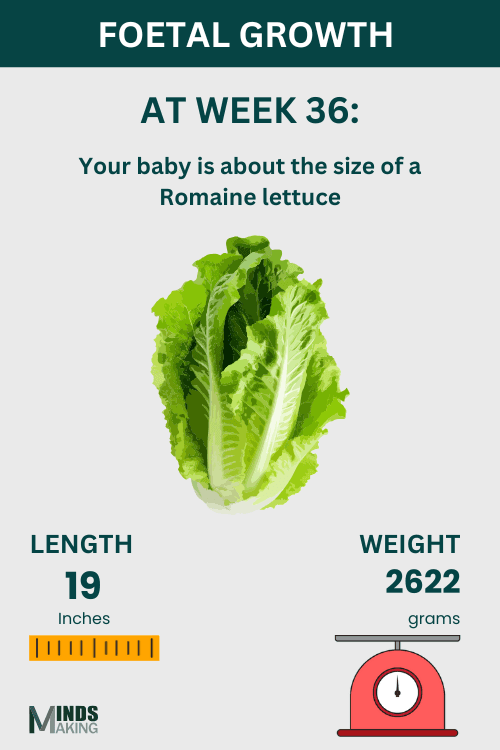
Body Changes at Week 36
Your baby is still gaining weight, but you probably won't see much change in your weight. You might feel like there's hardly any room left for your baby to grow and be quite tired of feeling so "big," but remember that the longer your baby stays in its protective environment until the due date, the better. You may also notice an increase in Braxton Hicks contractions. Many women experiencing these contractions go to the hospital only to find out it's a false alarm or false labour. While this can be frustrating, it is good practice for the real thing. Eventually, true labour contractions will follow the Braxton Hicks contractions.
It's common to experience changes in your appetite. As your baby grows, your expanding bump can press against your stomach, making it harder to eat large meals. You might find that you become full more quickly. However, because your body has increased energy needs, you may also get hungry again soon after eating. This happens because you consume smaller amounts of food at each meal but need more frequent, smaller meals to meet your energy requirements.
Read This Next
No posts available
Baby Bump At Week 36
By around 36 weeks, or in the following weeks, your uterus will have completed its expansion as you reach full term. It may now weigh around 2 ½ pounds.
As your belly expands, your centre of gravity shifts forward, making it harder to maintain balance. This is especially noticeable when walking, as the connective tissues in your pelvic area become softer and looser to prepare for childbirth.
Additionally, your spine and pelvis begin to curve to support the extra weight of your growing tummy, further contributing to the waddle-like walk. This movement is completely normal and part of your body's natural adjustments as you get closer to giving birth.
Pregnancy Symptoms at Week 36

Lightening
As your baby moves down into your pelvic cavity, the pressure on your diaphragm eases, leading to what's known as lightening. This relieves the pressure on your diaphragm, the muscle that helps you breathe. As a result, you'll likely notice that your stomach feels less compressed, making it easier to take deeper breaths. You might also find that you can eat more comfortably, as your stomach isn't as squashed as before. This is a common and welcome relief in the later stages of pregnancy.

Dry, itchy skin
At this point, your belly will be stretched to the extent that your skin may feel very dry and likely quite itchy. To alleviate this, try using soothing creams with cocoa butter or Vitamin E for the best results. You might also ask your partner to apply the cream for you while gently talking to the baby, it's a lovely way for him to bond with your developing little one.

Pelvic pain
Pelvic pain, often felt as sharp pain, soreness, stinging, or burning in the hips or groin, affects about 30% of expecting mothers. It typically starts around the 18th week of pregnancy but can occasionally start as early as weeks 8-10 and as late as three weeks after delivery. This pain is mainly caused by pregnancy hormones that loosen ligaments, allowing bones to shift and pressure nearby muscles. Weight gain and a changing centre of gravity also contribute. If you're experiencing pelvic pain, there are several ways to find relief. Wearing pregnancy bands or belts can help stabilise your pelvis, while physical therapy, acupuncture, and Tylenol can reduce the discomfort.

Cramping
Mild cramping is normal and not a cause for concern. It can result from various factors, such as bloating, constipation, and round ligament pain. At this stage in your pregnancy, cramping might also occur due to Braxton Hicks contractions, which are false labour pains. However, cramping can sometimes signal the onset of labour. It's important to contact your healthcare provider if you experience contractions with lower back pain, more than six contractions in an hour (even if they aren't painful), contractions at regular intervals, or if you notice vaginal discharge or bleeding.
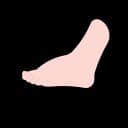
Numbness in legs and feet
Your growing body can place extra pressure on certain nerves in your legs, feet, and hands, leading to occasional numbness or a tingling sensation. These symptoms are typically harmless and should go away after you give birth. However, speaking with your healthcare provider is a good idea if you're around 36 weeks pregnant and find these sensations particularly bothersome. They might suggest using ankle or wrist splints to help relieve the pressure or advise you to rest your hands and feet as much as possible to alleviate the discomfort.
Pregnancy Concerns at Week 36
If you start experiencing contractions or think you might have them, it's important to call your doctor or go to the hospital. You should also reach out to your doctor if you notice vaginal bleeding, fluid leakage, or severe abdominal pain.
As your baby grows and space becomes tighter, their movements may slow down a bit. However, you should still be able to feel them moving. If you notice a decrease in movement, such as fewer than 10 movements in an hour, or if you're concerned about your baby's activity, contact your doctor immediately.
While decreased movement might not be a serious issue, it could also indicate your baby is in distress. It's always better to be cautious and consult your healthcare professional if you have any concerns.
Health Tips for Pregnancy Week 36
Get enough vitamin C
Ensure you consume at least 85 milligrams of vitamin C daily to support your immune system, bones, and muscles. Vitamin C-rich foods include citrus fruits, strawberries, broccoli, and tomatoes. For example, a medium orange has about 70 milligrams of vitamin C, while a cup of orange juice can provide over 90 milligrams. Taking prenatal vitamins might already include the necessary vitamin C. Consult your healthcare provider to confirm if you are meeting your daily vitamin C needs.
Avoid spicy foods
If you're craving chips and salsa but have been dealing with heartburn, it's a good idea to resist the temptation. While spicy or acidic foods like salsa can be delicious, they can also trigger or worsen heartburn, leaving you with discomfort afterwards. It's often better to stick with bland foods, even if they seem less exciting, to avoid that burning sensation. Additionally, it's wise to avoid foods high in citrus, vinegar, or fried foods, as they can all contribute to heartburn, even if they taste great.
Avoid electronic screens before bedtime
Staring at electronic screens, such as those on TVs, mobile phones, or tablets, before bed can interfere with your sleep quality. These screens emit blue light, which can trick your brain into thinking it is still daytime. This light disrupts the production of melatonin, the hormone responsible for regulating sleep, making it harder for you to fall asleep and achieve restful sleep. Limiting screen time at least an hour before bedtime is advisable to improve sleep quality. Instead, engage in relaxing activities like reading a book, meditating, or taking a warm bath to help your body wind down for the night.
Take breaks to rest
Swollen feet and ankles can find much-needed relief with a bit of rest. It's important to take breaks to rest, and when you lie down, place a pillow under your feet to elevate them above heart level. This position helps reduce swelling by improving circulation and allowing excess fluid to drain away from your lower extremities. Resting in this way eases discomfort and gives your body a chance to recover from the physical demands of late pregnancy.
Ensure adequate pyridoxine
Another important nutrient this week is pyridoxine, commonly known as vitamin B6. This vitamin is crucial in helping your body and baby utilise proteins for cell building. Pyridoxine also supports the development of your baby's brain and nervous system, potentially influencing your baby's future intelligence. Vitamin B6 is found in various foods, including spinach, eggs, bananas, milk, meat, soybeans, oatmeal, broccoli, chicken breast, green peas, tomatoes, potatoes, avocados, and more.
Advice for Partners
While your partner must have her bag packed for the hospital, there are also items you can pack to prepare for the delivery. Consider including:
- Change of clothes to stay comfortable.
- Pyjamas If you plan on staying overnight.
- Watch with a second hand for timing contractions.
- Video/Camera if you want to capture the moment, ensure it's okay with your partner first and remember extra batteries and chargers.
Pregnancy Checklist for Week 36
- Set aside some time for yourself as well, gentle exercise, yoga, and deep breathing exercises can all help you feel more relaxed and better equipped for the weeks ahead. These activities can also improve your sleep and help you feel more rested.
- If you haven't chosen a paediatrician for your baby yet, now is the time to do so. You'll need to see your baby's doctor shortly after birth, whether in the hospital or after your discharge, so it's a good idea to find a suitable one during pregnancy.
- Explore your options for feeding your baby. Your healthcare provider can discuss both breastfeeding and formula feeding with you.
- Make sure to discuss the signs of labour with your doctor or midwife. Your provider should also give you clear instructions on when to call and when to go to the hospital or birth centre if they haven't already.
- If your baby is putting pressure on your pelvis, you might consider investing in a belly sling or band to help alleviate some of the strain. Wear it only briefly and avoid tightening it too much, which could restrict blood flow.
Frequently Asked Questions
How big is my baby at week 36 of pregnancy?
Your baby is 19 inches long by the thirty-sixth week and weighs 2622 grams. They are as big as romaine lettuce. Your baby's head is more in proportion to its body.
Is it safe to give birth in week 36 of pregnancy?
At 36 weeks, babies are classified as late preterm. While it's generally recommended to wait until at least 39 weeks for delivery, some babies are born earlier, and in certain situations, early delivery may be necessary. Even though the risk of complications is much lower after 36 weeks, late preterm infants can still face several health issues. Your doctor can help assess the risks of preterm delivery for your baby and work with you to develop a plan to ensure the safest and healthiest delivery possible.
What should I avoid at 36 weeks pregnant?
During pregnancy, it's important to avoid alcohol and smoking to lower the risk of complications such as miscarriage, premature birth, and foetal alcohol syndrome. You should also avoid unpasteurised dairy products and raw or undercooked meat, eggs, poultry, and fish, as these can carry harmful bacteria that may cause foodborne illnesses. Additionally, limit your caffeine intake to less than 200 mg daily and avoid fish high in mercury, like shark, swordfish, or raw shellfish, to protect your baby's health.
Is my baby fully developed at week 36?
Your baby is nearly fully developed and will soon be ready to enter the world. However, at 36 weeks, there's still some growing left to do. This includes gaining weight and allowing the brain, lungs, liver, and other organs to mature fully. For this reason, your baby should remain in your womb for a few more weeks.
Was this article helpful?
How many stars are you giving this article?
Leave a comment
Your email address will not be published.










































